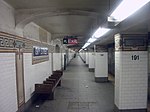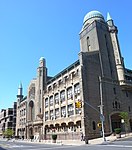Fort George Amusement Park
1894 establishments in New York (state)1914 disestablishments in New York (state)Amusement parks closed in 1914Amusement parks opened in 1894Buildings and structures in the United States destroyed by arson ... and 3 more
Defunct amusement parks in New York (state)Defunct buildings and structures in ManhattanWashington Heights, Manhattan

Fort George Amusement Park was a trolley park and amusement park that operated in the Washington Heights and Inwood neighborhoods of Upper Manhattan, New York City, in the late 19th and early 20th centuries. It occupied an area between 190th and 192nd Streets east of Amsterdam Avenue, within present-day Highbridge Park.
Excerpt from the Wikipedia article Fort George Amusement Park (License: CC BY-SA 3.0, Authors, Images).Fort George Amusement Park
Rough Ryder, New York Manhattan
Geographical coordinates (GPS) Address Nearby Places Show on map
Geographical coordinates (GPS)
| Latitude | Longitude |
|---|---|
| N 40.854444444444 ° | E -73.925833333333 ° |
Address
Rough Ryder
Rough Ryder
10034 New York, Manhattan
New York, United States
Open on Google Maps






